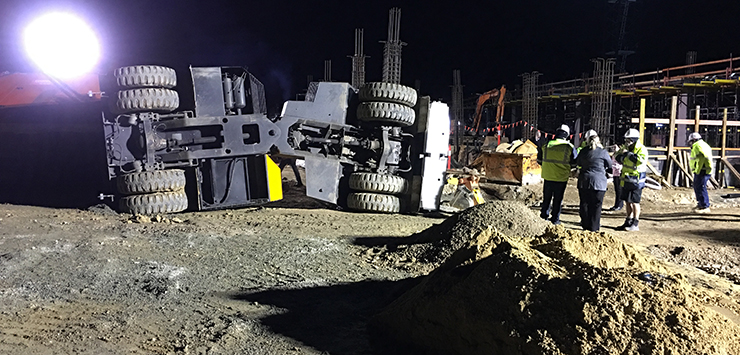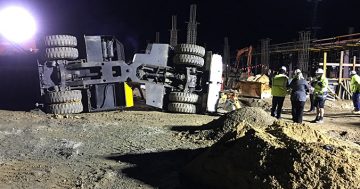
The University of Canberra Hospital worksite on the night of 4 August 2016 after a crane toppled and killed 62-year-old Herman Holtz. Photo: ACT Policing.
A major company facing $1.5 million in fines did not require a crane driver to complete a full safety assessment before operating a machine that overturned and killed another worker, a court has heard.
Herman Holtz, 62, died when the crane tipped and landed on him at the University of Canberra Hospital construction site in Bruce in 2016.
Members of his family and two directors from Multiplex Constructions sat on opposite sides of the ACT Industrial Court’s courtroom on Wednesday (10 November) to hear the company be sentenced.
Multiplex was the head contractor for the hospital worksite and, as detailed in an affidavit from a director, is a company with 1200 Australian employees, operates in six countries and has project values worth $90.3 billion since 1962.
The crane’s driver, Michael Watts, who was sentenced over his role last year, worked for subcontractor RAR Cranes.
Both companies had each pleaded guilty to single charges of failing to comply with a health and safety duty which exposed a person to the risk of death or serious injury.
Mr Holtz’ family was unable to tell the court about what impact his loss had on them during the sentencing for Multiplex, as after a long period of debate and consideration, Chief Magistrate Lorraine Walker ruled that the relevant legislation didn’t allow her to consider their victim impact statements.
“I can’t take into account your statements,” she told them. This was because while Mr Holtz died and they had “undoubtedly” suffered harm, his death was not due to Multiplex’s offence.
The court heard Watts didn’t fully complete a particular form that required a full safety assessment before the crane started to lift a generator.
Garry Livermore QC, representing Multiplex, said the company failed to get Watts to complete this form and, by doing so, failed to minimise risk as much as possible.
According to the facts of the case against Multiplex, a 10.3-tonne diesel-powered electrical generator had to be moved around the worksite to power a tower crane. On the afternoon of 4 August 2019, the company contacted RAR Cranes requesting a crane for the job.
A site inspector working for RAR Cranes, who initially recommended a much larger crane, contacted his office and arranged for a 25-tonne crane to come to the site after discussions with Multiplex employees.
When Watts arrived with the crane, he did not do a full risk assessment of the lift, including checking the slope of the path he was going to take, which would have shown that the degree of the slope exceeded the crane’s abilities. There were other issues, such as how the proposed lift was outside the safe lifting capacity of the crane. Also, a counterweight was fitted in the wrong direction resulting in weight monitoring inaccuracies.
Several people were standing around the crane at about 6:40 pm when it tipped to the right, with the gravity of the generator pulling it down. The tip of the crane’s boom hit Mr Holtz, crushing him into the ground and killing him instantly.
When the crane tipped, it was overloaded to about 130 per cent of its rated capacity.
Mr Livermore said the overloading of the crane happened just before it tipped due to the height the generator was at and the articulation of the boom.
He said at least four assessments were carried out by RAR Cranes, not including what Watts did, regarding using the crane to carry the generator so Multiplex had gone a “significant way” to fulfil its duty.
“It is a risk that should have been foreseen … but the prospects of that happening [the crane tipping] were remote,” he said.
Mr Livermore also said the crane didn’t tip because Watts didn’t fill out the required document, it tipped because he operated the crane recklessly.
But prosecutor Dr Kylie Weston-Scheuber said what Watts did when overloading the crane, such as extending the boom, were “the very things” to be considered in the document, called a site-specific risk assessment.
She said Watts didn’t fill out the document because Multiplex didn’t require him to do that.
“There is no explanation as to why the form wasn’t required to be filled out in the first place,” she said.
She also said there was no evidence in the statement of facts for the case that Watts was suitably qualified for the job.
Mr Livermore wanted Multiplex to be sentenced to an appropriate penalty, saying “you don’t get a bigger fine because you’re a company with a big turnover”.
However, Dr Weston-Scheuber said the capacity of a company to pay a fine and its size was directly relevant to the penalty to be imposed.
Magistrate Walker will hand down her sentence on Multiplex on Friday (12 November). The company faces a maximum fine of $1.5 million.
RAR Cranes will be sentenced on 24 January 2022. Watts had pleaded guilty to a charge of reckless conduct exposing persons to a risk of serious injury or death and in April 2020 was sentenced to 12 months’ jail, fully suspended.














oh dear and here I thought we could pack all of our things and be ready for the move... gunna have… View